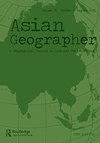日本3·11海啸后,一家博物馆的位置感发生了变化
IF 2.2
Q2 GEOGRAPHY
引用次数: 4
摘要
摘要2011年3月11日,日本发生了有史以来最强烈的地震。气仙沼是宫城县的一个沿海港口和渔业城市,是受灾最严重的人口中心之一,海浪摧毁了该市的大部分商业核心和几乎所有的低海岸社区。海浪的破坏凸显了这座城市的某些地方感,并永远改变了其他地方。我探索气仙沼鲨鱼博物馆是如何反映出“3·11”灾难同时维持和改变气仙沼这个地方的。我分析了博物馆的空间性,以及它的叙事如何在更广泛的社区中唤起一种地方感。鲨鱼博物馆的案例是学者如何利用博物馆来研究地方感以及它如何受到自然灾害的影响的一个例子。这项工作对文化地理学研究博物馆的空间性、博物馆体验以及这些空间如何反映人与地方之间的互动做出了独特贡献。本文章由计算机程序翻译,如有差异,请以英文原文为准。
Evoking a shifting sense of place in one museum following the 3/11 tsunami in Japan
ABSTRACT On March 11, 2011, Japan experienced the most powerful earthquake ever recorded in that country. A coastal port and fishing city in Miyagi Prefecture, Kesennuma was one of the hardest hit population centers, the waves having destroyed much of the city’s commercial core and nearly all of its low coastal neighborhoods. The wave’s destruction highlighted certain elements of the city’s sense of place and forever changed others. I explore how the Kesennuma Shark Museum reflects ways in which the 3/11 disaster has simultaneously maintained and altered Kesennuma as a place. I analyze the spatiality of the museum and how its narrative evokes a sense of place in the broader community. The case of the Shark Museum is one example of how scholars can use museums to examine sense of place and how it has been impacted by natural disasters. This work represents a unique contribution to cultural geography inquiry into the spatiality of museums, museum experiences, and how such spaces reflect an interaction between people and place.
求助全文
通过发布文献求助,成功后即可免费获取论文全文。
去求助
来源期刊

Asian Geographer
GEOGRAPHY-
CiteScore
3.30
自引率
0.00%
发文量
7
期刊介绍:
Asian Geographer disseminates knowledge about geographical problems and issues focusing on Asia and the Pacific Rim. Papers dealing with other regions should have a linkage to Asia and the Pacific Rim. Original and timely articles dealing with any field of physical or human geographical inquiries and methodologies will be considered for publication. We welcome, for example, submissions on people-environment interactions, urban and regional development, transport and large infrastructure, migration, natural disasters and their management, environment and energy issues. While the focus of the journal is placed on original research articles, review papers as well as viewpoints and research notes under the category of “Asian Geography in Brief” are also considered. Review papers should critically and constructively analyse the current state of understanding on geographical and planning topics in Asia. The ‘Asian Geography in Brief’ section welcomes submissions of applied geographical and planning research about Asia. The section aims to showcase (1) the diverse geography and planning of Asia; and (2) the diverse geographical and planning research about Asia. The journal will also publish special issues on particular themes or areas. Book reviews can be included from time to time.
 求助内容:
求助内容: 应助结果提醒方式:
应助结果提醒方式:


